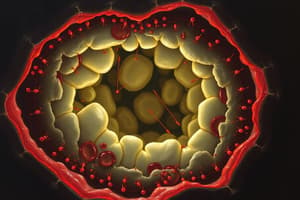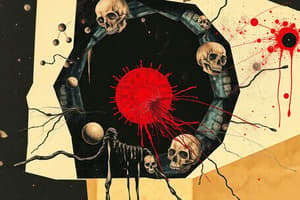Podcast
Questions and Answers
What is the primary characteristic that distinguishes necrosis from apoptosis?
What is the primary characteristic that distinguishes necrosis from apoptosis?
- Necrosis triggers inflammation and tissue damage. (correct)
- Necrosis is a regulated process.
- Apoptosis involves cell swelling.
- Apoptosis occurs due to external factors only.
Which pathway is initiated by internal cellular damage during apoptosis?
Which pathway is initiated by internal cellular damage during apoptosis?
- Necrotic pathway
- Extrinsic pathway
- Intrinsic pathway (correct)
- Caspase pathway
During which process do cells typically undergo chromatin condensation?
During which process do cells typically undergo chromatin condensation?
- Apoptosis (correct)
- Autophagy
- Necrosis
- Inflammatory response
What is a consequence of necrosis for surrounding tissues?
What is a consequence of necrosis for surrounding tissues?
What initiates the extrinsic pathway of apoptosis?
What initiates the extrinsic pathway of apoptosis?
Which event is most closely associated with necrosis?
Which event is most closely associated with necrosis?
What is a feature of apoptosis that differentiates it from other forms of cell death?
What is a feature of apoptosis that differentiates it from other forms of cell death?
Which factor is NOT typically associated with necrosis?
Which factor is NOT typically associated with necrosis?
What is a key characteristic that differentiates apoptosis from necrosis?
What is a key characteristic that differentiates apoptosis from necrosis?
How does autophagy contribute to cellular health during stress?
How does autophagy contribute to cellular health during stress?
Which of the following processes does NOT involve caspases?
Which of the following processes does NOT involve caspases?
What occurs when autophagy is excessively activated?
What occurs when autophagy is excessively activated?
What is the primary role of caspases in apoptosis?
What is the primary role of caspases in apoptosis?
Under what condition does autophagy primarily operate?
Under what condition does autophagy primarily operate?
What happens to the apoptotic bodies formed during apoptosis?
What happens to the apoptotic bodies formed during apoptosis?
Which process is primarily responsible for cell rupture and inflammation?
Which process is primarily responsible for cell rupture and inflammation?
What can be said about apoptosis concerning energy requirement?
What can be said about apoptosis concerning energy requirement?
Which statement best describes the relationship between autophagy and apoptosis?
Which statement best describes the relationship between autophagy and apoptosis?
What is the main difference between apoptosis and necrosis?
What is the main difference between apoptosis and necrosis?
During embryonic development, what role does apoptosis play in shaping tissues?
During embryonic development, what role does apoptosis play in shaping tissues?
Which of the following best describes ‘apoptotic bodies’?
Which of the following best describes ‘apoptotic bodies’?
In the developing nervous system, what is the primary function of apoptosis?
In the developing nervous system, what is the primary function of apoptosis?
What purpose does autophagy serve in cellular homeostasis?
What purpose does autophagy serve in cellular homeostasis?
What is the role of procaspase-3 in apoptosis?
What is the role of procaspase-3 in apoptosis?
What initiates the extrinsic pathway of apoptosis?
What initiates the extrinsic pathway of apoptosis?
Which protein is involved in the formation of the apoptosome?
Which protein is involved in the formation of the apoptosome?
Which process does Bax primarily influence during apoptosis?
Which process does Bax primarily influence during apoptosis?
What impact does the mitochondrial permeability transition pore (MPTP) have in cell death?
What impact does the mitochondrial permeability transition pore (MPTP) have in cell death?
What is the primary function of cyclophilin D?
What is the primary function of cyclophilin D?
Which statement accurately describes procaspase-9?
Which statement accurately describes procaspase-9?
Which component is NOT part of the intrinsic apoptosis pathway?
Which component is NOT part of the intrinsic apoptosis pathway?
What is a direct consequence of cytochrome c release into the cytosol?
What is a direct consequence of cytochrome c release into the cytosol?
How does the activity of caspase-3 contribute to the execution phase of apoptosis?
How does the activity of caspase-3 contribute to the execution phase of apoptosis?
Which caspase initiates the extrinsic pathway of apoptosis?
Which caspase initiates the extrinsic pathway of apoptosis?
What is the role of cytochrome c in the intrinsic pathway of apoptosis?
What is the role of cytochrome c in the intrinsic pathway of apoptosis?
What is the primary action of caspase-activated DNase (CAD) during apoptosis?
What is the primary action of caspase-activated DNase (CAD) during apoptosis?
What differentiates apoptosis from necrosis with regard to cellular contents?
What differentiates apoptosis from necrosis with regard to cellular contents?
Which pro-apoptotic proteins are primarily responsible for mitochondrial outer membrane permeabilization (MOMP)?
Which pro-apoptotic proteins are primarily responsible for mitochondrial outer membrane permeabilization (MOMP)?
In which phase of apoptosis are executioner caspases activated?
In which phase of apoptosis are executioner caspases activated?
What occurs during chromatin condensation in apoptotic cells?
What occurs during chromatin condensation in apoptotic cells?
What is the result of the release of Smac/DIABLO from the mitochondria during apoptosis?
What is the result of the release of Smac/DIABLO from the mitochondria during apoptosis?
Which of the following describes the timeline of the apoptosis process?
Which of the following describes the timeline of the apoptosis process?
What triggers the activation of CAD in apoptosis?
What triggers the activation of CAD in apoptosis?
Study Notes
Necrosis
- Uncontrolled form of cell death caused by injury, infection, or extreme stress.
- Characterized by cell swelling, membrane rupture, and inflammatory response.
- Involves release of intracellular contents into extracellular space, causing tissue damage.
- Commonly results from ischemia, toxins, or trauma.
- Key features include being passive, external triggers, and harmful outcomes for surrounding tissue.
Apoptosis
- Programmed cell death, highly regulated, allowing removal of damaged or unnecessary cells without inflammation.
- Initiated by intrinsic (internal damage) or extrinsic (external signals) pathways.
- Involves controlled processes: cell shrinkage, chromatin condensation, DNA fragmentation, and formation of apoptotic bodies.
- Intrinsic pathway: Activated by DNA damage; includes mitochondrial outer membrane permeabilization and caspase-9 activation.
- Extrinsic pathway: Triggered by death ligands binding to receptors; activates caspase-8.
- Key features include energy dependence, caspase involvement, and non-inflammatory removal of cells.
Autophagy
- Survival mechanism where cells degrade and recycle damaged organelles or proteins to maintain homeostasis.
- Not a form of cell death; can delay apoptosis by promoting repair under stress.
- Begins with autophagosome formation, leading to lysosomal degradation of engulfed components.
- Does not involve caspases or result in DNA fragmentation.
- Aids in nutrient provision during stressful conditions without causing inflammation.
Comparative Summary
- Necrosis is uncontrolled and harmful, leading to tissue damage and inflammation, while apoptosis is a clean, regulated process that avoids inflammation.
- Autophagy promotes survival and repair through recycling of damaged components but is not inherently lethal like necrosis or apoptosis.
Caspase Pathways
- Procaspase-3 and Caspase-3 play critical roles in the execution phase of apoptosis.
- Procaspase-8 activates in the extrinsic pathway upon death receptor engagement, initiating the apoptotic cascade.
- Procaspase-9 is activated in the intrinsic pathway via the apoptosome, which begins the cascade.
Mitochondria's Role in Apoptosis
- Central to the intrinsic pathway, releasing cytochrome c which forms the apoptosome and activates caspase-9.
- Involved in releasing other pro-apoptotic factors that promote cell death.
DNA Fragmentation in Apoptosis
- Activation of endonucleases (CAD) results in DNA fragmentation; chromatin condenses, leading to a characteristic pattern.
- Controlled process in apoptosis, contrasting with necrosis where DNA is released in a chaotic manner causing inflammation.
Stages of Apoptosis
- Initiation phase involves activation of initiator caspases.
- Execution phase consists of executioner caspases cleaving cellular proteins, leading to cell shrinkage.
- Formation of apoptotic bodies occurs, which are later phagocytosed to prevent inflammation.
Role in Development and Function
- Apoptosis shapes tissues during embryonic development, removing excess or misplaced cells (e.g., separation of fingers).
- Essential in neuronal development, eliminating excess neurons to ensure proper connections.
- Supports the maturation of organisms by removing unnecessary structures during growth.
Studying That Suits You
Use AI to generate personalized quizzes and flashcards to suit your learning preferences.
Related Documents
Description
This quiz compares and contrasts necrosis, apoptosis, and autophagy, highlighting the main steps and characteristics of each process. Learn about the triggers and consequences of these distinct forms of cell death or survival. Test your understanding of these critical biological concepts.




